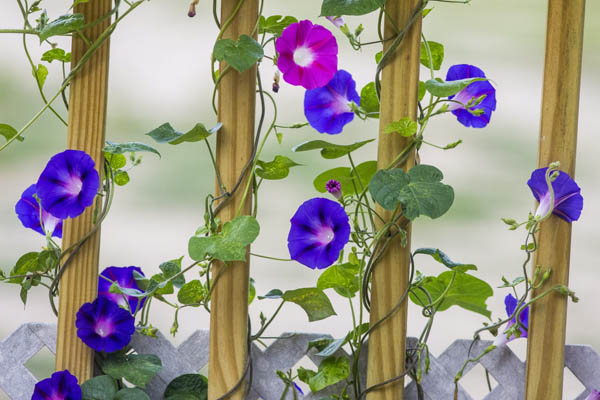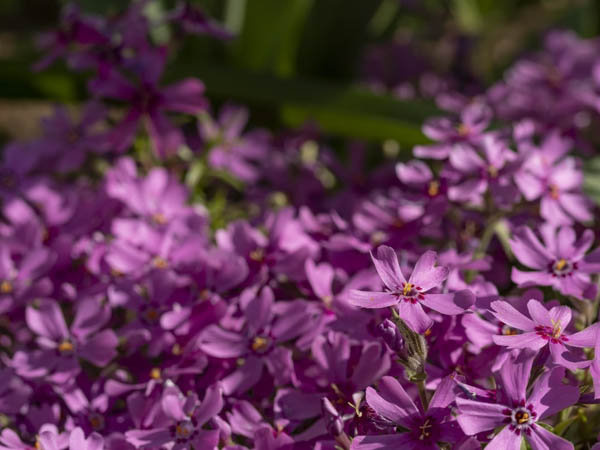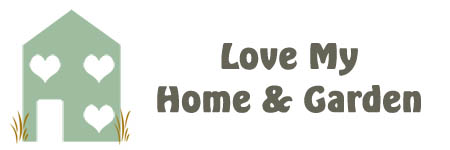A perennial plant is a plant that lives for more than two years. There are many different types of perennial plants. Some are annual flowers that can be grown from seed each year, while others are shrubs or trees.
In this article, we’ll take a look at 10 low maintenance perennial flowers that would be perfect for your garden!
Types of Low Maintenance Perennial Flowers

1. Morning Glory
Morning glory plants have been popular in gardens for centuries, which makes a lot of sense considering they’re so easy to grow. If you have room for a perennial flower garden and are in a sunny location, you can plant a morning glory plant right in the beginning of the season.
Morning Glory plants are also one of the easiest to nurture; they grow like weeds. Even if you’ve never planted a flower before, morning glory flowers are the perfect choice if you’re looking to plant low maintenance perennial flowers in your garden. Morning glory flowers grow quickly and produce abundant blooms, which can be used in many different ways. You can plant them in your yard and they will grow quickly. You can also plant them in containers and give them a window sill indoors. They’re ideal as a climbing plant and work best when used with trellis.
There are many different varieties of morning glory flowers, but all of them have the same basic characteristics: large, trumpet-shaped flowers, large numbers of flowers (usually hundreds of flowers), and large flat leaves. The flowers are usually bright blue, pink, yellow, or white. At their centre is a double trumpet shape, composed of both a long tube and a shorter tube that are close together at the centre. The colour of the flower depends on the species of flower.
2. Snapdragon
The snapdragon flower (Antirrhinum) is native to the Mediterranean region of Europe and the Middle East. It is a perennial plant with attractive large flowers that are perfectly shaped to catch the wind, and it is often grown as an ornamental plant in gardens.
Snapdragons are easy to grow and are tolerant of a wide range of soils and climates. They are a popular choice as an annual flower in gardens, as they bloom quickly and produce large quantities of flowers. They are also suitable for use in containers, as they do not require a lot of room to grow. If you’re new to gardening, the snapdragon is a great choice for your first flower, as it is easy to care for and produces beautiful flowers.
Though they are perennial plants that can withstand the wintry seasons, they are short lived. Most people class them as annual plants instead and replant them in Spring.
As their roots can rot, it’s important that they are placed in soil with good drainage that is in full or partial sun coverage. They require regular watering and do best when kept away from ripe fruits and vegetables. Deadheading them also helps snapdragons to continue to produce wonderful blooms.
Depending on the species you decide on, Snapdragons grow to a range of heights, either dwarf, medium or tall, and produce a colourful bloom that will brighten any garden.
3. Daffodil
Flowers are always beautiful, but the daffodil flower is the star of the spring garden. Although there are many different types of daffodils, their stunning blossoms are made of five petals and are often yellow, but can also be white, pink or purple. The flowers that grow on the bulb can either be in groups of two or three, or they can be in groups of four, five or even more. To create a daffodil garden, plant bulbs in a bed of rich soil.
Daffodils are a very popular low maintenance perennial flower that are traditionally used to decorate spring and summer in the UK, but many gardeners around the world enjoy their bright yellow and orange flowers throughout the year. The flowers can be grown in a variety of conditions, but are most at home in damp, well-drained soil. It is important that the soil is not packed, as this can restrict the roots of the plant and cause the flowers to droop. Daffodils also prefer to be in a position where they will receive a good amount of sunlight; they will tolerate partial shade but are better off in full sun.
The daffodil flower grows in the wild in the UK, France, and Germany, but is not native to the U.S. (for example, the flower does not grow in the wild in the south, or anywhere in the Pacific Northwest). Daffodils are related to the tulips and other members of the onion family, and the daffodil is part of the same family for those reasons.
4. Ruby Giant
You may have seen ruby giant flowers in the colour purple, a bold deep purple, or perhaps a shocking deep hue of magenta. It’s a striking flower, making a statement with its giant size, and its deep coloration.
The plant is a member of the Heliantheae that grows in the mountains of Southern France, Italy, Spain and is also grown in other countries. The plant had a long history as herbal medicine, and it is still used by many people in the Mediterranean region.
As a crocus, the Ruby Giant is a dwarf plant that does best when positioned in the sunlight with well-drained soil. It can cope in containers as well as in flower beds and gardens. The best time of year to plant Ruby Giants are in early autumn. They take up to 5 years to mature to their maximum height.

5. Daisy
The daisy flower is a favourite of gardeners, landscapers and farmers everywhere. They are easy to cultivate, and you can see them sprout from seed in no time. They are a variety of flower that is popular because they are a monochromatic flower with a yellow centre. The name is thought to come from the Greek word for ‘day’, as they bloom on days of the week named after a single flower, such as daisies, pansies, and sweet peas.
Daisy flowers are often seen as the quintessential flower and have been around for over a hundred years. Often associated with springtime, they grow best in cooler climates. The daisy flower is a perennial flower which is often used as a symbol of eternal love or beauty.
Belonging to the Asteraceae family, daisies like the sun and are a hardy flower which means they’re easy to grow and hard to kill. Species of daisies, like Gerbera Daisies and Marguerite Daisies, have big, beautiful blooms that attract bees and butterflies too.
6. Carnation
The carnation flower (Dianthus caryophyllus) is one of the most delicate and beautiful flowers in the world. The name carnation is derived from the color of the petals, which are often described as being ‘carnation pink’ or ‘carnation red’ or ‘carnation crimson’. The carnation flower is one of the garden plants that are very easy to grow and can be grown successfully through spring, summer and autumn from seeds in your own garden.
Carnations are one of the most popular perennials for gardeners, especially for weddings. They bloom for a relatively long time, and have a fairly broad appeal—they’re florals, so they go with pretty much all kinds of wedding attire.
Carnations are among the most familiar spring flowers, and the flower’s popularity stems from the variety of colors it produces. They begin to bloom late spring and do best in well-drained soil.
Though they are a hardy flower that need little maintenance, Carnations that are fertilised can produce a better bloom.
7. Lily of the Valley
Lily of the Valley (Lamium galeobdolon) are perennial flowering shrubs that have become incredibly popular in recent years. While you might think of them as being more of a luxury plant, they can actually be very useful, being useful as a ground cover, in a border scheme and as a flowering plant.
Lily of the Valley has a simple, pretty and sometimes delicate beauty. Although it can be grown indoors, Lily of the Valley will fare best in a border with partial shade and moist soil though it can also thrive in clay soil.
Lily of the Valley are easily the most common type of “lily” grown in gardens, and are also considered to be a true perennial plant, which means they will remain in the ground for several seasons, rather than going to seed and dying in the winter. The flowers can be used in a range of arrangements, and also have a long blooming period, which makes them particularly useful as cut flowers.
The bell-shaped white flowers of the Lily of the Valley are sweet-scented and thereby attract butterflies and bees during the summer months.
8. Delphiniums
From zinnias and lilies to violets, it’s almost impossible to visit your favourite garden centre or nursery without coming across a delphinium. These beautiful flowers have a long history and are still popular today, making them a favourite with gardeners.
A delphinium flower is technically a hybrid of types of flowers, which means it’s a member of a family of plants (the Ranunculaceae) that includes most of your typical garden flowers, as well as some that are not normally growing in gardens. (Think purple coneflower or foxglove.)
Delphiniums are popular perennial plants that are easy to grow, and they produce beautiful, delicate flowers. They also make great cut flowers and they can be used in bouquets and mixed with other flowers in arrangements. If you are looking to add some colour to your garden and enjoy some beautiful blooms, delphiniums are a great choice.
Delphiniums are a genus of flowering plants in the buttercup family Ranunculaceae, native to temperate Asia and Europe. Most are herbaceous perennial plants, but a few are woody. They range in size from 15 to 60 cm (6 to 24 in), with flowers on erect stems.
The delphinium is one of the most popular perennials for spring gardens.
9. Yarrow
Yarrow is a popular herb that resembles both a miniature daisy and a valerian plant. It can be used both fresh and dried, but its recipe is quite simple: yarrow is commonly used as a tea to treat colds, and can ease a sore throat. There are also many other ways to use yarrow: as an anti-inflammatory, as an anti-anxiety herb, and, of course, as a tonic for the eyes, among other uses.
The yarrow plant is an herbaceous perennial that belongs to the daisy family. It grows to a height of up to 20 inches, with finely divided leaves that are light green in color and sometimes tinged with purple. The flowers emerge from tall spikes in a variety of colours, including purple, yellow, white, orange, and pink.
Yarrow flowers bloom in the spring and produce small, yellow-green, four-petalled flowers that bloom from March through May.
The Yarrow plant needs very little maintenance and blooms best in full sun and planted in well-drained soil.

10. Phlox
As spring rolls in and summer approaches, more and more people are looking to add a splash of colour to their landscape. One plant that fits the bill perfectly is the bright and cheerful phlo . They’re lovely in their own right, but also attractive because of their ability to attract a range of butterflies, bees, and other pollinators. To help ensure their continued beauty and long lives, learn how to plant phlox in your garden and protect them from garden pests and disease.
The phlox is a low maintenance perennial flower that thrives in the semi-shade as it’s often seen in woodland. The plant produces very showy flowers that bloom in the spring and summer months. The phlox flower reaches up to four inches in height, and it grows between three and five inches wide. The flowers can be seen in a range of colours, including shades of pink, red and purple. The flower’s colour and size can vary depending on the type of soil. They grow best in rich, well-drained soil. Most phlox plants are hardy and are able to withstand a wide range of weather conditions, including freezing temperatures.
If you’re looking for beautiful ground coverage, then creeping phlox can provide stunning blanket colour.


Be the first to comment